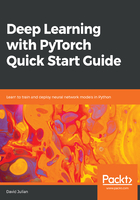
Amazon Web Services (AWS)
AWS is the original cloud computing platform, most noted for its highly-scalable architecture. It offers a vast array of products. What we need to begin is an EC2 instance. This can be accessed form the Services tab of the AWS control panel. From there, select EC2 and then Launch Instance. From here, you can choose the machine image you require. AWS provide several types of machine images specifically for deep learning. Feel free to experiment with any of these but the one we are going to use here is the deep learning AMI for Ubuntu version 10. It comes with pre-installed environments for PyTorch and TensorFlow. After selecting this, you get to choose other options. The default T2 micro with 2 GB of memory should be fine to experiment with; however, if you want GPU acceleration, you will need to use the T2 medium instance type. Finally, when you launch your instance, you will be prompted to create and download your public-private key pair. You can then use your SSH client to connect to the server instance and tunnel in to the Jupyter Notebook as per the previous instructions. Once again, check the documentation for the finer details. Amazon has a pay-per-resource model, so it is important you monitor what resources you are using to ensure you do not receive any unnecessary or unexpected charges.